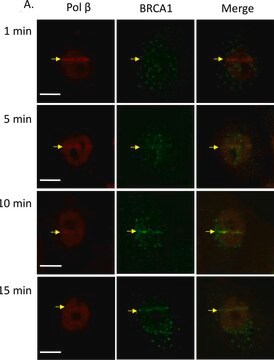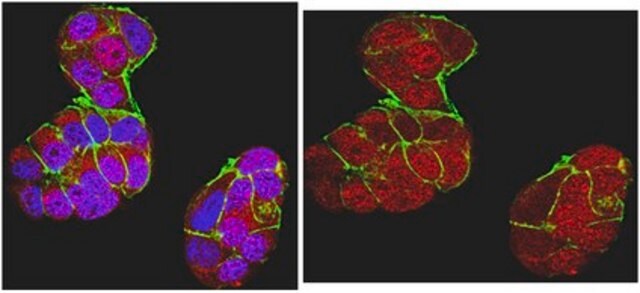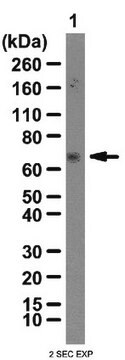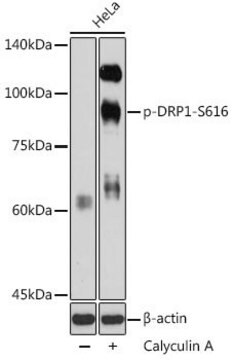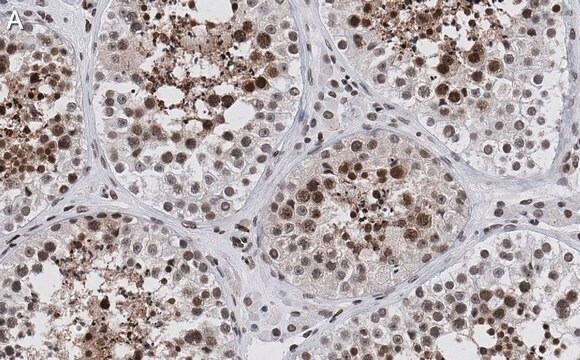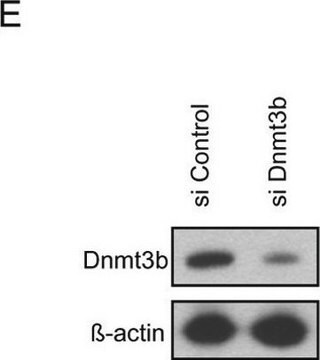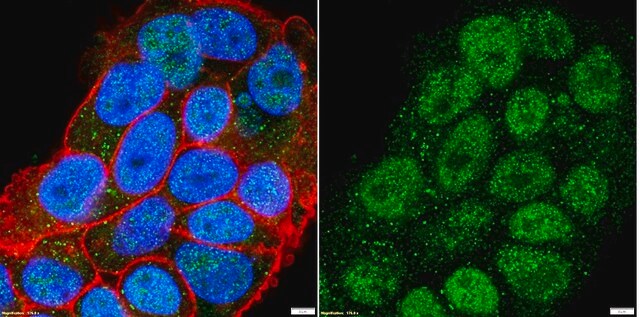07-434
Anti-BRCA1 Antibody
serum, Upstate®
Synonym(s):
Anti-BRCAI, Anti-BRCC1, Anti-BROVCA1, Anti-FANCS, Anti-IRIS, Anti-PNCA4, Anti-PPP1R53, Anti-PSCP, Anti-RNF53
Sign Into View Organizational & Contract Pricing
Select a Size
All Photos(1)
Select a Size
Change View
About This Item
UNSPSC Code:
12352203
eCl@ss:
32160702
NACRES:
NA.41
Recommended Products
General description
Two major susceptibility genes for breast cancer, BRCA1 and BRCA2, have been identified. Both genes are considered to be tumor-suppressor genes. Mutations within BRCA1 and BRCA2 are responsible for most familial breast cancer cases. Functional analyses of the BRCA1 and BRCA2 gene products have established their dual participation in transcription regulation and DNA damage repair. BRCA1 affects cell cycle regulation and loss of BRCA1 function due to decreased expression leads to cell cycle arrest, through p53 and p21 genes. In vivo, BRCA1 and BRCA2 are expressed at maximal levels in rapidly proliferating cells. This feature is consistent with in vitro observations that BRCA1 and BRCA2 are expressed in a cell cycle-dependent manner. During mammary gland development, the expression of BRCA1 and BRCA2 is induced in rapidly proliferating cellular compartments.
Specificity
Recognizes human BRCA1.
Immunogen
GST-tagged fusion protein corresponding to amino acids 1301-1863 of human BRCA1.
Application
Detect BRCA1 with Anti-BRCA1 Antibody (Rabbit Polyclonal Antibody), that has been shown to work in IHC, IP & WB. This BRCA1 antibody has been tested in human samples.
Research Category
Epigenetics & Nuclear Function
Epigenetics & Nuclear Function
Research Sub Category
Cell Cycle, DNA Replication & Repair
Cell Cycle, DNA Replication & Repair
Quality
routinely evaluated by immunoblot in HeLa nuclear extract
Target description
220 kDa
Physical form
Serum containing 0.035% sodium azide and 30% glycerol. Liquid at -20°C.
Unpurified
Storage and Stability
Maintain for 2 years at -20°C from date of shipment. Aliquot to avoid repeated freezing and thawing. For maximum recovery of product, centrifuge the original vial after thawing and prior to removing the cap.
Analysis Note
Control
Positive Antigen Control: Catalog #12-309, Hela cell nuclear extract. Add an equal volume of Laemmli reducing sample buffer to 10 μL of extract and boil for 5 minutes to reduce the preparation. Load 20 μg of reduced extract per lane for minigels.
Positive Antigen Control: Catalog #12-309, Hela cell nuclear extract. Add an equal volume of Laemmli reducing sample buffer to 10 μL of extract and boil for 5 minutes to reduce the preparation. Load 20 μg of reduced extract per lane for minigels.
Other Notes
Concentration: Please refer to the Certificate of Analysis for the lot-specific concentration.
Legal Information
UPSTATE is a registered trademark of Merck KGaA, Darmstadt, Germany
Disclaimer
Unless otherwise stated in our catalog or other company documentation accompanying the product(s), our products are intended for research use only and are not to be used for any other purpose, which includes but is not limited to, unauthorized commercial uses, in vitro diagnostic uses, ex vivo or in vivo therapeutic uses or any type of consumption or application to humans or animals.
Not finding the right product?
Try our Product Selector Tool.
recommended
Product No.
Description
Pricing
Storage Class Code
12 - Non Combustible Liquids
WGK
WGK 1
Flash Point(F)
Not applicable
Flash Point(C)
Not applicable
Certificates of Analysis (COA)
Search for Certificates of Analysis (COA) by entering the products Lot/Batch Number. Lot and Batch Numbers can be found on a product’s label following the words ‘Lot’ or ‘Batch’.
Already Own This Product?
Find documentation for the products that you have recently purchased in the Document Library.
Breast cancer-associated Abraxas mutation disrupts nuclear localization and DNA damage response functions.
Solyom, S; Aressy, B; Pylkas, K; Patterson-Fortin, J; Hartikainen, JM; Kallioniemi et al.
Science Translational Medicine null
Erin George et al.
JCI insight, 2(1), e89760-e89760 (2017-01-18)
Approximately 50% of high-grade serous ovarian cancers (HGSOCs) have defects in genes involved in homologous recombination (HR) (i.e., BRCA1/2). Preclinical models to optimize therapeutic strategies for HR-deficient (HRD) HGSOC are lacking. We developed a preclinical platform for HRD HGSOCs that
BAL1 and its partner E3 ligase, BBAP, link Poly(ADP-ribose) activation, ubiquitylation, and double-strand DNA repair independent of ATM, MDC1, and RNF8.
Yan, Q; Xu, R; Zhu, L; Cheng, X; Wang, Z; Manis, J; Shipp, MA
Molecular and cellular biology null
Judith J Luciani et al.
Journal of cell science, 119(Pt 12), 2518-2531 (2006-06-01)
We have recently demonstrated that heterochromatin HP1 proteins are aberrantly distributed in lymphocytes of patients with immunodeficiency, centromeric instability and facial dysmorphy (ICF) syndrome. The three HP1 proteins accumulate in one giant body over the 1qh and 16qh juxtacentromeric heterochromatins
The chromatin remodeling protein BRG1 modulates BRCA1 response to UV irradiation by regulating ATR/ATM activation.
Zhang, L; Chen, H; Gong, M; Gong, F
Frontiers in Oncology null
Our team of scientists has experience in all areas of research including Life Science, Material Science, Chemical Synthesis, Chromatography, Analytical and many others.
Contact Technical Service